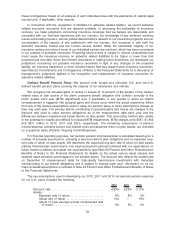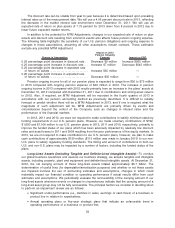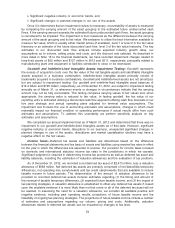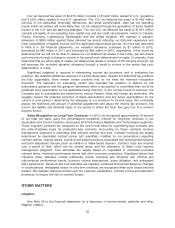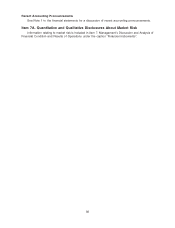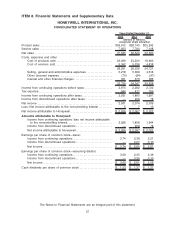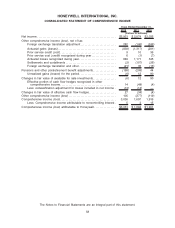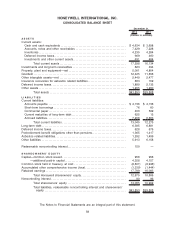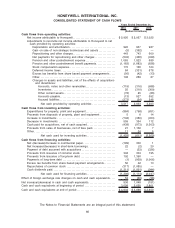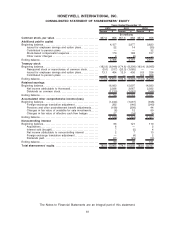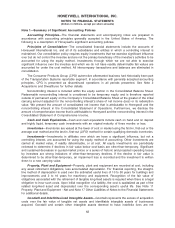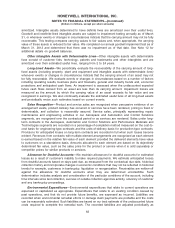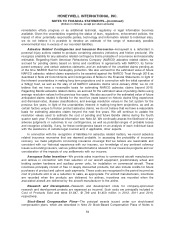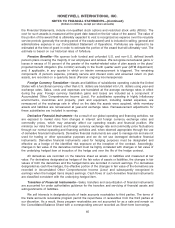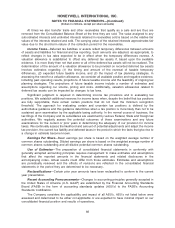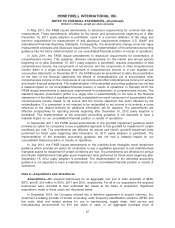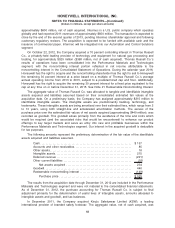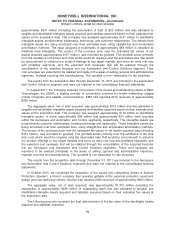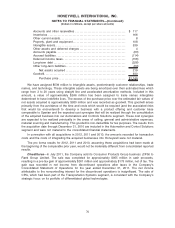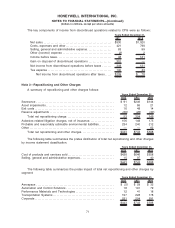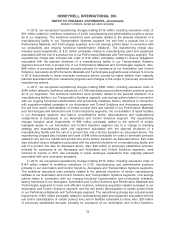Honeywell 2012 Annual Report Download - page 71
Download and view the complete annual report
Please find page 71 of the 2012 Honeywell annual report below. You can navigate through the pages in the report by either clicking on the pages listed below, or by using the keyword search tool below to find specific information within the annual report.Note 1—Summary of Significant Accounting Policies
Accounting Principles—The financial statements and accompanying notes are prepared in
accordance with accounting principles generally accepted in the United States of America. The
following is a description of Honeywell’s significant accounting policies.
Principles of Consolidation—The consolidated financial statements include the accounts of
Honeywell International Inc. and all of its subsidiaries and entities in which a controlling interest is
maintained. Our consolidation policy requires equity investments that we exercise significant influence
over but do not control the investee and are not the primary beneficiary of the investee’s activities to be
accounted for using the equity method. Investments through which we are not able to exercise
significant influence over the investee and which we do not have readily determinable fair values are
accounted for under the cost method. All intercompany transactions and balances are eliminated in
consolidation.
The Consumer Products Group (CPG) automotive aftermarket business had historically been part
of the Transportation Systems reportable segment. In accordance with generally accepted accounting
principles, CPG is presented as discontinued operations in all periods presented. See Note 2
Acquisitions and Divestitures for further details.
Noncontrolling interest is included within the equity section in the Consolidated Balance Sheet.
Redeemable noncontrolling interest is considered to be temporary equity and is therefore reported
outside of permanent equity on the Company’s Consolidated Balance Sheet at the greater of the initial
carrying amount adjusted for the noncontrolling interest’s share of net income (loss) or its redemption
value. We present the amount of consolidated net income that is attributable to Honeywell and the
noncontrolling interest in the Consolidated Statement of Operations. Furthermore, we disclose the
amount of comprehensive income that is attributable to Honeywell and the noncontrolling interest in the
Consolidated Statement of Comprehensive Income.
Cash and Cash Equivalents—Cash and cash equivalents include cash on hand and on deposit
and highly liquid, temporary cash investments with an original maturity of three months or less.
Inventories—Inventories are valued at the lower of cost or market using the first-in, first-out or the
average cost method and the last-in, first-out (LIFO) method for certain qualifying domestic inventories.
Investments—Investments in affiliates over which we have a significant influence, but not a
controlling interest, are accounted for using the equity method of accounting. Other investments are
carried at market value, if readily determinable, or at cost. All equity investments are periodically
reviewed to determine if declines in fair value below cost basis are other-than-temporary. Significant
and sustained decreases in quoted market prices or a series of historic and projected operating losses
by investees are strong indicators of other-than-temporary declines. If the decline in fair value is
determined to be other-than-temporary, an impairment loss is recorded and the investment is written
down to a new carrying value.
Property, Plant and Equipment—Property, plant and equipment are recorded at cost, including
any asset retirement obligations, less accumulated depreciation. For financial reporting, the straight-
line method of depreciation is used over the estimated useful lives of 10 to 50 years for buildings and
improvements and 2 to 16 years for machinery and equipment. Recognition of the fair value of
obligations associated with the retirement of tangible long-lived assets is required when there is a legal
obligation to incur such costs. Upon initial recognition of a liability, the cost is capitalized as part of the
related long-lived asset and depreciated over the corresponding asset’s useful life. See Note 11
Property, Plant and Equipment - Net and Note 17 Other Liabilities of Notes to the Financial Statements
for additional details.
Goodwill and Indefinite-Lived Intangible Assets—Goodwill represents the excess of acquisition
costs over the fair value of tangible net assets and identifiable intangible assets of businesses
acquired. Goodwill and certain other intangible assets deemed to have indefinite lives are not
62
HONEYWELL INTERNATIONAL INC.
NOTES TO FINANCIAL STATEMENTS
(Dollars in millions, except per share amounts)


